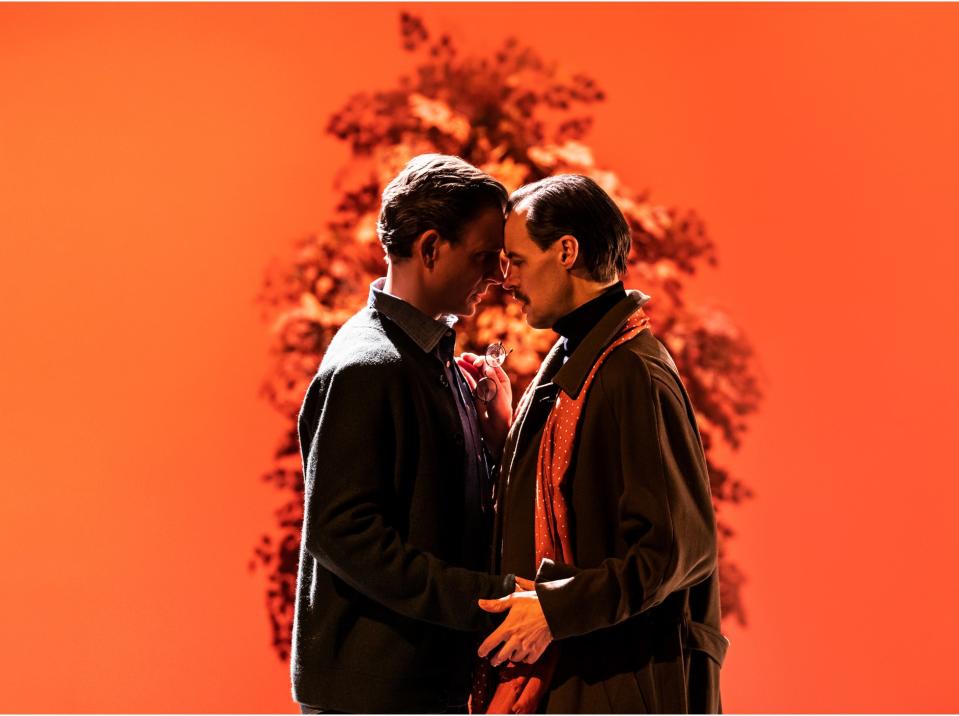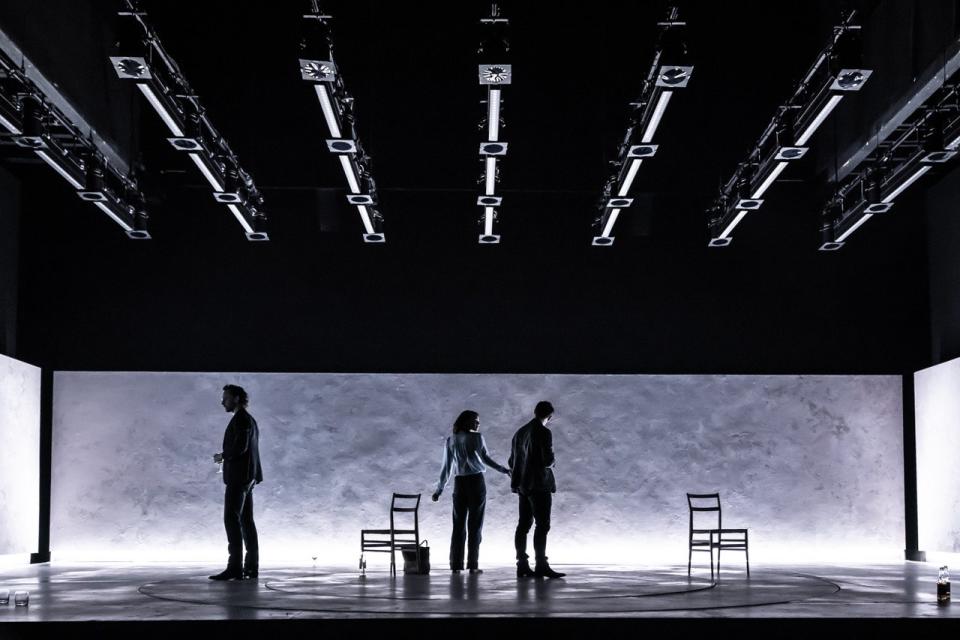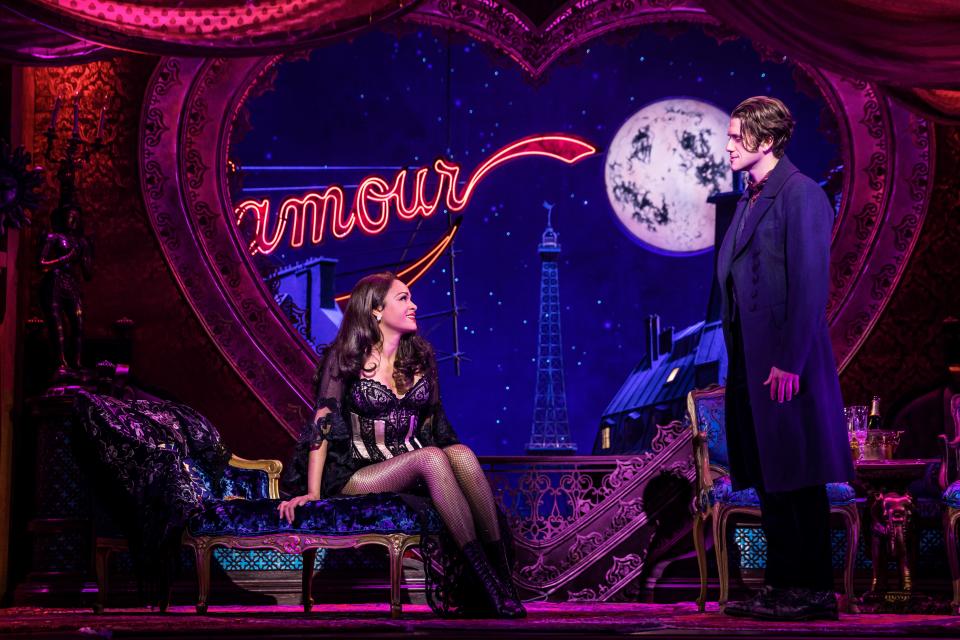Inside the Plays Nominated for Best Scenic Design at the Tony Awards
The American Theatre Wing’s Tony Awards has celebrated artistic achievements on Broadway each year since 1947, typically in the month of June. Unfortunately, the unprecedented pandemic had other plans for 2020.
Though the lights are still out on The Great White Way and the date and method of rewarding the nominees has changed, the show must go on. And while the date of the Tonys is still up in the air, the nominees have been announced, and a virtual show is expected to take place sometime this winter.
In the Best Scenic Design category, the nominees range from the frenzied jukebox musical Jagged Little Pill and the Belle Epoque sets of Moulin Rouge! The Musical to the somber serious dramas of The Inheritance and Betrayal, where minimalism is the order of the day.
And the nominees are….
Best Scenic Design of a Play—Drama
The Inheritance
Scenic Designer: Bob Crowley

Six-time Tony-Award winning set and costume designer Bob Crowley wears two hats in this two-part seven-hour play based on E.M. Forster’s Howard’s End. He created costumes for some 28 characters while designing the minimalist upstate country home of Henry Wilcox (that boasts a tree with pig’s teeth) and various locations of Manhattan, Hamptons, and Fire Island. The Inheritance trades the novel’s bourgeois society set for a group of contemporary gay New Yorkers who still feel the mental effects of the AIDS epidemic, and the themes are familiar. “The script was the most daunting thing to ever arrive on my doorstep. It was huge (some 400 pages), and from the minute I sat down, I was hooked. There are houses, apartments, streets in New York, and it’s multi-locational. I thought, how are we going to harness this thing,” Crowley tells AD.
The designer’s solution was to create a “floating platform” that serves as a stage within a stage and can rise and fall, forgoing the various locations and allowing the audience to use their imagination. “I knew it had to be really, really simple …the play is so well written that you always sort of know where you are. The audience doesn’t need all these rooms, streets, and houses with roofs. It just needs poetry.”
Betrayal
Scenic Designer: Soutra Gilmour

Creating the backdrop for the Harold Pinter classic Betrayal—which depicts the end of a marriage and an illicit affair—set and costume designer Soutra Gilmour opted for a minimalist approach, allowing the performances to speak for themselves in a psychological space. “The design for the production was deliberately stripped back. Gone are any real clues to the location,” notes the British designer. “The design is a frame to hold the actors as its key function is to maintain a tension and emotional temperature whilst alluding to a place without describing it.”
The drama takes place in an Italian hotel room, a pub, and in a London flat, with a pair of chairs by Italian Modernist architect Gio Ponti providing the main set décor. Gilmour utilized the theater’s low horizontal space on a rotating stage that moves back and forth in time, keeping up with the play’s story and “silently moving (the actors) seamlessly from one to the other in their triangular relationship.”
A Soldier’s Play
Scenic designer: Derek McLane

For the World War II period setting of A Soldier’s Play, directed by Kenny Leon, Emmy and Tony-Award winning scenic and production designer Derek McLane researched construction manuals of wooden wartime barracks and repurposed school buildings for the soldier’s housing and military offices. Charles Fuller’s Pulitzer Prize-winning story involves the murder of an African American sergeant (David Alan Grier) and the subsequent investigation by his captain (Blair Underwood) in 1944. McLane created the minimal sets with wood posts, slats, and beams, using the American flag as one of the few decorative elements. The sets move back and forth with flashbacks to the offices and the two-story living quarters. Another design element was the backdrop image of a Louisiana cloudscape that McLane says offers “a sense of heat and humidity.”
Slave Play
Scenic Designer: Clint Ramos

Set and costume designer Clint Ramos incorporated the alternating visions of director Robert O’Hara and writer Jeremy O. Harris. “Robert wanted intimacy in a colosseum style ‘in the round’ while Jeremy wanted illusion, allowing the audience to walk in and be transplanted to the deep South,” he tells AD. “The concept is always tricky when you deal with race issues, particularly explosive ones that are unblinking in terms of social critique.”
Acting as a self-professed “historian/scientist,” the Tony-Award winning designer researched the films Gone with the Wind and 12 Years a Slave and did a deep dive into southern plantation architecture as well as photos and illustrations from the period. Ramos illuminates the theater with the MacGregor House exterior on a lightbox that hovers above the audience, so they feel they are part of the setting. He also employed mirrors to create an intimate space that serves as a metaphor requiring the audience to really look at themselves. “The mirrors remind them of this ghost of the racial inequities of this country as we really don’t talk about race relations. It’s a metaphor for reckoning.” The three acts also included the sets of an antebellum bedroom complete with a lace canopy four-poster bed, a cotton field set, a group therapy room, and a hotel room.
Best Scenic Design of a Musical
Jagged Little Pill
Scenic Designers: Riccardo Hernández
Projection Designer: Lucy MacKinnon
![“The premise [of this set] was how we could take the notion of the American home and deconstruct it as the family is breaking apart and then put it all back together,” scenic designer Riccardo Hernández tells AD.](https://s.yimg.com/ny/api/res/1.2/ESgebb5m1oJR8l5MLPXA4w--/YXBwaWQ9aGlnaGxhbmRlcjt3PTk2MDtoPTY0MA--/https://media.zenfs.com/en/architectural_digest_422/7e2be5adcabce9203908a49912ce286a)
Inspired by Alanis Morissette’s 1995 Grammy Award-winning album Jagged Little Pill, the Broadway musical sensation tells the tale of the perils of suburban anxiety. Focusing on the wealthy Healy family and set in suburban Connecticut, it’s an American saga of a workaholic husband, pill-popping mother, their two sons (one Harvard bound), and adopted daughter.
Scenic designer Riccardo Hernández (who is also an assistant professor at the Yale School of Drama) began by sending images to the play’s director Diane Paulus of “McMansions in Connecticut that looked like architecture on steroids.” Inspired by the work of painter and graphic artist Robert Rauschenberg, the designer created sets that were constantly in motion, with sliding glass panels. He created four theatrical spaces at the Broadhurst Theater that ranged from a 90s American home in all its glorified excess to a set that speaks volumes as a black void.
And since the play falls into the jukebox musical genre, lighting and video projection are vital to the overall design scheme. Projection designer Lucy MacKinnon used realistic photo projections to create a backdrop that established the play’s locations. “We were trying to create emotional undertones as there is anger in the music, sadness, longing, and regret, so we created a chaotic effect through the images,” she says.
A Christmas Carol
Scenic Designer: Rob Howell

Scenic designer Rob Howell created the costumes and sets for the 2019 version of the classic Charles Dickens tale. “My goal was to make the audience feel they are sitting in the same world as the story is being told,” he tells AD. (The audience is also treated to a plate of cookies during the play). “How small can the space be and how fewer costumes can we use for everyone to still believe the character. There are no cobblestone streets, and we didn’t want Victorian shop windows. We wanted a cleaner, more bare stage that is believable of the time period,” he notes.
He chose a “dark grubby color palette,” indicative of the poverty-stricken times. “I deliberately tried to get away from the chocolate box or Christmas card version of the story where real poverty is covered up.”
Hundreds of lanterns hang over the set as both prop and metaphor. “Scrooge is trapped in a dark, world of his own making, and the three ghosts of past, present, and future visit him before he accepts light into his life,” says Howell. The lanterns proved to be a logistical nightmare as it was a problem transporting hundreds of fixtures into the theater. Howell sourced inexpensive contemporary pieces at Home Depot, and the scenic artists created their magic, making them look hundreds of years old.
Moulin Rouge! The Musical
Scenic Designer: Derek McLane

Translating director Baz Luhrmann’s memorable 2002 Oscar-nominated film from the big screen to the Broadway stage was an intriguing challenge for scenic designer Derek McLane. “A couple of things I wanted to take away from the movie was to keep the energy going, the rapid-fire cameras zipping around from place to place and figuring out how to do that on stage. I also wanted to capture the moment of the action happening around the audience and make them feel they are a part of it,” says the designer, who met with Luhrmann and his wife, Catherine Martin, the film’s production and costume designer.
The charming and diverse neighborhood of the Montmartre and the legend of the famous colorful cabaret provided plenty of inspiration for him to work with. “It was a very decadent time where artists were into Moroccan art, Indian textiles, and crafts with a sort of exoticism that was very chic,” says McLane.
One of the most important design motifs is the ever-present heart shaped portals (particularly Satine’s window in her apartment) that the designer recalls from the movie. “We didn’t want to be beholden to it and decided to make the heart portals quite elaborate and more detailed with the architecture. When you do a play, everything’s multiplied by ten.” Windmills also dot various parts of the red velvet draped sets, from the light fixtures to decorative boxes. McLane’s desire was to remind the audience of the original while giving them a fresh theater experience. Mission accomplice.
Tina – The Tina Turner Musical
Scenic Designer: Mark Thompson
Projection Designer: Jeff Sugg

British set and costume designer and five-time Tony-Award nominee Mark Thompson and award-winning projection designer Jeff Sugg created the overall look of the stage bio-musical, providing a backdrop to Tina Turner’s iconic pop songs and the overall drama of her tumultuous life. “It’s not really sets, the whole piece is a memory story,” Thompson tells AD. “Suggestiveness is important as the sets are more dreamscapes and much more poetic. We tried to find a language to make it as easy and liquid as possible.”
Sugg first researched the rock icon’s life by watching her documentary. The use of video projections transports the audience from setting to setting while supporting the music and capturing her energy on the stage. “I would take these very disparate places and weave this magical realism and then bring a spiritual element to it,” he details. “I latched onto this in the video stuff and would try to draw these visual narratives that came in and out of this dreamworld – we called it etherland.”
Originally Appeared on Architectural Digest

